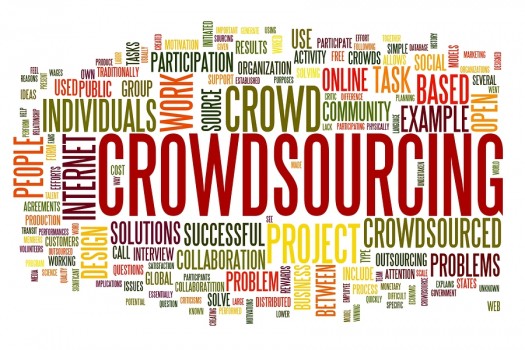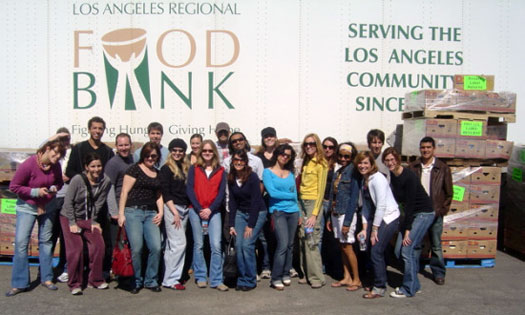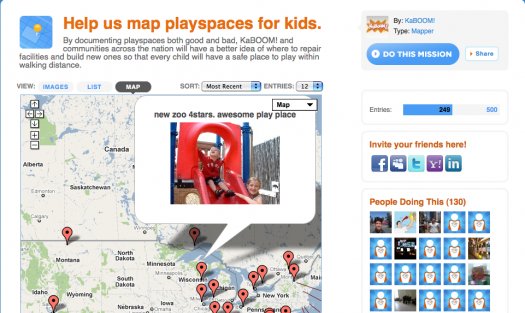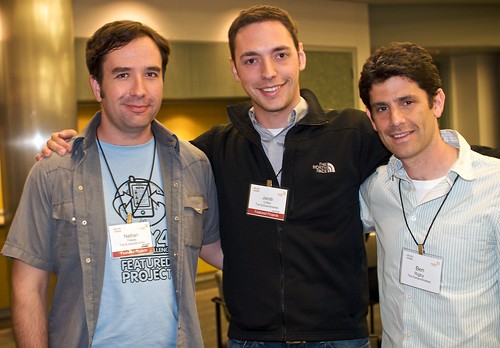The post How crowdsourcing can help your nonprofit appeared first on Socialbrite.
]]>
Best practices to help you leverage the power of the crowd
Guest post by Soha El Borno
Idealware
Target audience: Nonprofits, cause organizations, foundations, NGOs, social enterprises, businesses, general public.
 Crowdsourcing can help you harness the crowd to increase awareness, cultivate new volunteers, gather information and even get work done — all for a minimal investment. How can you put it to work for your nonprofit or organization?
Crowdsourcing can help you harness the crowd to increase awareness, cultivate new volunteers, gather information and even get work done — all for a minimal investment. How can you put it to work for your nonprofit or organization?
Since the earliest days of the Internet, people have used it to solicit and organize groups of people to participate in projects in small ways. Called crowdsourcing, this process can be done in a number of ways and used for a variety of goals.
In an early example of the practice, nonprofits would post questions to a Usenet discussion board to seek answers from the community — for instance, asking how to write a particular policy, or for recommendations about recognizing and rewarding volunteers. That “open call” approach is what distinguishes crowdsourcing from outsourcing, in which you’d send a task to a specific person or organization for help.
Crowdsourcing can be done at an organizational or individual level, and nonprofits have used it for everything from marketing and fundraising to volunteerism and activism. It’s a great way to enlist help from a wider community knowledge base, and to engage people in your work.
In the last few years, the rise of social media and new technologies made it easier to reach and engage a broader audience. But how can your organization harness the power of the crowd to help achieve your mission? We asked nonprofit experts and professionals for crowdsourcing best practices and techniques that have worked for them.
The whys and hows of crowdsourcing
Nonprofits can use crowdsourcing for a number of purposes, including cultivating new volunteers and donors and spreading the word about your organization’s work to a larger audience.
At its simplest, crowdsourcing is community engagement. Engaging a community — whether it’s your local community, your group of volunteers, donors and clients, or a community of like-minded people who share an interest in your cause — can provide you with ideas, feedback and contributions you might not otherwise get. It can also demonstrate transparency and openness in decision-making. Whoever is in charge of your nonprofit’s Facebook and Twitter activities should keep an eye out for questions to regularly ask followers about activities and events to help keep them engaged.
But there are some cautions to keep in mind, the most important of which is to keep crowdsourcing simple and meaningful. For example, if your organization is drafting a social media policy, your volunteer manager might share a draft with an online community of volunteers and ask for their feedback. If your organization wanted to come up with new plans for an annual fundraising event, your fundraising manager might email all your organization’s supporters to ask for ideas.
We’ve identified five categories of crowdsourcing, and found some real-world examples of nonprofits that have used them successfully.
Pooling collective knowledge
1This category follows the idea that two heads—or more—are better than one. This type of crowdsourcing can be used to share and aggregate information to help solve problems. For example, Ushahidi is an open-source software platform that plots a set of particular incidents, submitted by people via cell phone text messages, onto an online map. Ushahidi, which means “testimony” in Swahili, was initially developed to map reports of violence in Kenya after the post-election fallout at the beginning of 2008. It has also been used in disaster relief in Pakistan and to map crime incidents in Atlanta.
In an older example, a public radio station in New York City asked listeners to check the price of milk at their neighborhood store and enter it online. Several hundred submissions later, the station had created a detailed map of food prices showing inequities across the city.
Microvolunteering (asking the crowd to help with tiny tasks)
2By breaking large tasks into tiny ones, it’s possible to outsource repetitive jobs to the crowd. For instance, The Seed Company enlisted more than 1,000 residents of a remote village in Asia for help translating the Bible into their native language, with each participant translating a small piece of text. The project was made possible using the crowdsource translation platform Lingotek. Through sites like Sparked or Amazon’s Mechanical Turk, organizations can ask people to perform a small task, such as tagging a picture, finding a phone number or typing a particular piece of text in a specific format. After Hurricane Katrina, for example, thousands of volunteers manually entered 15,200 records to consolidate all the dozens of sources of information about lost or missing people.
Crowd creation
3Tasks of this nature use crowds to help create original works of art. For example, The Royal Opera used Twitter to crowdsource a new “people’s opera” that drew more than 900 contributions, resulting in a 20-minute production in London performed by professional composers. Similarly, the San Francisco Symphony crowdsourced musician auditions for a mash-up performance over YouTube. The end result was a symphony orchestra of more than 90 players representing over 30 countries.
Crowd voting
4Everyone has an opinion, and most people like to express them by voting on or rating something or giving feedback. By tapping into that desire, you can increase awareness for your cause and draw in new audiences for your message. A great example of this is the Brooklyn Community Foundation, which launched a campaign encouraging locals to submit and vote on projects to make the borough a better place. More than 356 projects were nominated, and the number of votes totaled well over 300,000.
Art museums have also used crowdsourcing to let crowds curate and plan exhibitions. A good example is the Brooklyn Museum’s “Click! A Crowd-Curated Exhibition,” which involved an open call for people to submit photographs. Nearly 3,500 people participated, evaluating more than 350 images and selecting a number for a final exhibition of the photographs in 2008.
Crowd funding
5This category opens the collective pocketbook, encouraging crowds to fund projects that benefit others. Perhaps the most widely known is Kiva, a micro-lending website that uses crowdsourcing for its work. By allowing people to make micro-loans as small as $25 to entrepreneurs in developing countries, the site taps into the generosity of donors to change the lives of thousands in the developing world.
Across the United States, communities are harnessing crowds to provide funds for nonprofits on special “giving days.” In Minnesota, Give to the Max Day raised more than $13.4 million in November 2011, and GiveMN, an affiliated website, raised $46 million since its launch in 2009.
Any of these categories can be used on its own or combined with other approaches to achieve your goals.
Tips for successful crowdsourcing
Crowdsourcing and crowd funding projects are within reach of any organization, but there are a few things to keep in mind that will help ensure your success.
- Plan ahead. Start by choosing the right model for your goals. Figure out what you’re trying to achieve and find the best way to do it. Make sure you choose the right crowd, too — setting up a crowdsourcing campaign is the easy part, but getting the word out to the right people is not. Create a fully developed outreach plan, and use a combination of social media and emails to current supporters. These people, in turn, will have access to networks of people with similar interests, and help you pass your project along. If you’re using a crowd-funding site, like Kickstarter or Indiegogo, make sure you choose the one that most closely matches your goal — each has a different approach.
- Keep it simple. Make it very clear what you want the crowd to do, and break down your strategic goals into smaller tasks people can help with. Keep your message as easy as possible to communicate to help it get passed along. In order to help you meet your goal, set reasonable expectations. Crowd-funding is an easy way to ask for donations, but it creates the illusion that hordes of people with large amounts of money are sitting at their computers looking for some place to give it away. Most successful crowd-funding initiatives rely on friends, family and colleagues rather than total strangers. All the same traditional fundraising rules apply: You have to have credibility, you have to have a strong network, you have to have a track record of success, and you have to be transparent on how the money will be used.
- Engage the crowd and reward participation. Approach crowdsourcing as an opportunity to engage a new group of potential supporters. Be as creative as possible in your outreach and plant your campaign in places that you hope will reach new audiences. Think about how to regularly engage with your current supporters and start doing it. Consider giving incentives to reward participation — what do people want in exchange for their help? Try to really understand their motivation. Do they just want to be heard, have fun or learn something new? In this case, a simple acknowledgment might work, but other times, cash incentives might be used.
- Stay positive — both publicly and privately. Throughout the campaign, it’s important to remain personable with the people who might contribute, and a little personal interaction can increase the likelihood of a donation or action. Have faith in the process and stay focused on your mission — if an activity doesn’t obviously support your mission, forget it.
Crowdsourcing is more than a tactic, it’s a mindset
Crowdsourcing provides many opportunities for nonprofits to tap the power of crowds. If you have a task, question or idea you want to explore, there are many ways to reach and involve people. Always look for opportunities to ask questions or seek feedback from your volunteers, donors, newsletter subscribers, clients, the local community or any community.
Crowdsourcing is a mindset. Want your community to be a part of your decision-making process? Don’t get mired in top-down thinking, and don’t be afraid to take risks or listen to criticism from your constituents or the public. Running a crowdsourcing project is a lot of work. The best approach to accomplishing it is to take your time and just chip away at it. Read through all the necessary steps and complete one task at a time. Unless you are in a rush, there is no rush to complete this. In the end, the tools don’t matter. What’s important is coming up with meaningful ways to engage, learning from other organizations that have successfully used crowdsourcing and have faith in the process.
 This work is licensed under a Creative Commons Attribution-NonCommercial-ShareAlike 3.0 Unported.
This work is licensed under a Creative Commons Attribution-NonCommercial-ShareAlike 3.0 Unported.
The post How crowdsourcing can help your nonprofit appeared first on Socialbrite.
]]>The post NCVS: Innovation and volunteerism appeared first on Socialbrite.
]]>
CNN anchor and special correspondent Soledad O’Brien at NCVS this week.
 This week I participated in the National Conference on Volunteering and Service for the first time. The annual conference, held in New Orleans this year, brought together about 4,500 thought leaders in the community and volunteer sectors across America.
This week I participated in the National Conference on Volunteering and Service for the first time. The annual conference, held in New Orleans this year, brought together about 4,500 thought leaders in the community and volunteer sectors across America.
It kicked off Sunday with a Social Media for Social Good bootcamp that I put on with George Weiner of DoSomething.org, which drew more than 60 participants. (See our presentation here.)
But I’d rather talk about some of the other highlights I came across, and share this 100-photo Flickr gallery of the event.
Brian Reich and Scott Henderson put on a fascinating Idea Throwdown that I took part in, along with representatives from AARP, CauseCast, VolunteerMatch, MyImpact, TechSoup Global and a couple of dozen other organizations. Some outputs from that 2-hour gathering included the following:
• Participants ought to think about partnering with like-minded movements instead of launching duplicative efforts. We should be paying close attention to working together as a front, and participating in cross-sector collaboration, rather than claiming credit as trend-setters. Talk to three competitors and figure out how you can work together.
• Chris Noble: “Kill a feature a week and a program a month and your organization will get better.”
• In his “Information to Impact” session, George Weiner said, “If you’re never surprised by what you find in the data, you’re not asking the right questions.” And this priceless gem: “Data is better than gut.”
• Neil Bush, chairman of the Points of Light Institute: “Twenty years ago over 30 million people were volunteering. Today over 60 million people are.”
• I also was a panelist in Chris Noble’s session on “Brands and Causes” and argued that we need new language in the cause marketing space, especially around the nexus between nonprofit causes and corporate behavior.
• In my discussions with social entrepreneurs, we’re pretty much in agreement: Companies are too often looked at as sources of funding rather than as sources of solutions.
• Wonderful to be a few feet away from such celebrities as Soledad O’Brien of CNN (pictured above), James Carville, Mary Matalin, Neil Bush, Wynton Marsalis and many more.
 This work is licensed under a Creative Commons Attribution 3.0 Unported.
This work is licensed under a Creative Commons Attribution 3.0 Unported.
The post NCVS: Innovation and volunteerism appeared first on Socialbrite.
]]>The post Celebrate the Martin Luther King holiday over dinner appeared first on Socialbrite.
]]>
For MLK Day 2011, sign up and then eat, talk, change
Guest post by Jessica Kirkwood
Points of Light Institute
The 25th anniversary of the celebration of the Martin Luther King, Jr. holiday is only a few days away.
Over the years, honoring Dr. King’s legacy through volunteer service is an idea that’s taken hold, and it’s a fitting way to remember a man who lived his life in service to others.
This year, you can also celebrate the King holiday over dinner.
 Creating the change we’d like to see in the world works best when we talk and collaborate with our neighbors. And is there a better place to talk than when we’re gathered around the dinner table?
Creating the change we’d like to see in the world works best when we talk and collaborate with our neighbors. And is there a better place to talk than when we’re gathered around the dinner table?
On Sunday, Jan. 16, the night before MLK Day, people all across America will gather in restaurants, coffee shops, community centers and private homes to discuss what matters to them, to identify challenges facing their communities and to imagine solutions.
Picture yourself discussing your community’s needs with neighbors you’ve already met or those you haven’t. What ideas for improving your community might be developed collectively? What innovation, born over broken bread, might become real change over time? What if we made it possible for our children to participate in these conversations?
This year, in addition to volunteering on MLK Day, consider hosting or joining a Sunday Supper to reflect on how far we’ve come and how much we’d still like to do to ensure the health and well-being of our communities. You can download a facilitator’s toolkit (PDF) and conversation cards to get the discussion going here.
If you can’t join a Sunday Supper event in person, you can participate in the virtual conversation by watching the America’ s Sunday Supper live webcast this Sunday at 6 p.m. EST (3 p.m. PST).
Arianna Huffington of the Huffington Post, NBA legend Dikembe Mutombo, Olympic legend Carl Lewis, S. Leo Chiang, the producer and director of “A Village Called Versailles,” Barton Seaver, cook and National Geographic Fellow, Michelle Nunn of Points of Light Institute, Robert Egger of DC Central Kitchen and other special guests will share their thoughts on civic engagement, volunteerism and how to continue the work of Dr. King.
Be part of something bigger than yourself this MLK Day. Make it meaningful by serving others in Dr. King’s honor and also by creating a space and time for meaningful reflection and conversation.

 This work is licensed under a Creative Commons Attribution 3.0 Unported.
This work is licensed under a Creative Commons Attribution 3.0 Unported.
The post Celebrate the Martin Luther King holiday over dinner appeared first on Socialbrite.
]]>The post Catchafire: Connecting nonprofits & professionals appeared first on Socialbrite.
]]>Jane Slusser: Connecting nonprofits & volunteers from JD Lasica on Vimeo.
 At the Craigslist Foundation Boot Camp held Aug. 21 in Berkeley, Calif., I met tons of cool people, but none were more interesting than Jane Slusser, chief service officer of Catchafire.
At the Craigslist Foundation Boot Camp held Aug. 21 in Berkeley, Calif., I met tons of cool people, but none were more interesting than Jane Slusser, chief service officer of Catchafire.
 Catchafire is a new online marketplace that connects professionals who want to volunteer their skills with nonprofits and social enterprises that need their help. Nonprofits and social businesses register on the site and tell which projects they need help with.
Catchafire is a new online marketplace that connects professionals who want to volunteer their skills with nonprofits and social enterprises that need their help. Nonprofits and social businesses register on the site and tell which projects they need help with.
“People expect a lot more of the volunteer experience now,” says Jane, who came to Catchafire by way of the Obama campaign, where she mobilized volunteers to travel to key states during the primaries.
Watch, download or embed the video on Vimeo
Catchafire helps professionals offer their talents for worthy organizations they find an affinity with. Social enterprises can register on the site through the same portal as nonprofits. To prevent against volunteers spinning their wheels, Catchafire makes sure that both nonprofits and social enterprises have skin in the game by having internal resources and staff members dedicated to work on the project.
The start-up held a big event in New York on June 28 for the 50 Project Kickoff with speakers from charity:water, Drop.io, Pepsi Refresh and other organizations.
While a number of promising Web 2.0 start-ups have launched in the social good space in the past year, Catchafire is one to watch.
• See Catchafire’s blog
• See Catchafire’s Facebook Page
• Follow Catchafire/founder Rachael Chong on Twitter
Update: Jane also points to these key pages:
• Professionals can sign up to volunteer on the volunteer page.
• Nonprofits & social enterprises can register on the nonprofit page.
 This work is licensed under a Creative Commons Attribution 3.0 Unported.
This work is licensed under a Creative Commons Attribution 3.0 Unported.
The post Catchafire: Connecting nonprofits & professionals appeared first on Socialbrite.
]]>The post How to get involved and give back this summer appeared first on Socialbrite.
]]>
This originally appeared as a guest post on VolunteerSpot’s Summer of Service blog series.
 Iknow what many people say. They want to give back but they don’t know how. They want to get involved and volunteer in their community but they don’t know where to start. Well, we’re here to help!
Iknow what many people say. They want to give back but they don’t know how. They want to get involved and volunteer in their community but they don’t know where to start. Well, we’re here to help!
In just one hour, you’ll have the ideas, tools, resources and motivation to get started. So let’s start this summer off with a new sense of how to give back.
For a lot of people, they go online to volunteer websites and start scrolling through the options. Everything looks good, or nothing, or somewhere in between, and they’re not sure what to pick. This is the vortex of indecision, and not where you should start!
First, block an hour from your calendar when you won’t be distracted and can sit and focus on the task at hand. Sit in a comfortable place with a blank piece of paper or in front of a blank document on your computer (with your browser closed!) and follow along with the exercise below. You’ll be identifying the key components needed to finding a nonprofit right for you and then we’ll provide the resources where you can find that match. Ready? Let’s go!
Write down the names of nonprofits that interest you. These can be nonprofits you’ve donated to in the past — maybe you’ve participated in a walk or event or have read about a cause or charity and are interested in learning more. Geographic location doesn’t matter; just start making creating a list of those nonprofits.
Write down the type of nonprofits or causes that you’re passionate about. My list would look something like: economic development, grassroots environmental groups, women’s issues (specifically girls’ education and financial literacy), health issues (specifically malaria prevention and treatment) and poverty alleviation. For you maybe it’s children or pets or house building. There is no right number to write down, if the list gets longer than five, prioritize your list to make going back later and looking at it easier for you.
Write down the type of skills or environment you want to volunteer in. Are you looking to lend your current professional expertise like create a marketing plan for a small nonprofit or provide legal counsel in a pro bono setting, or are you looking to do something completely different like plant a garden in a school or walk dogs at shelter? Do you want an opportunity you can do at home like translation services for an international aid organization, or do you want to be around a group of people? Volunteer opportunities vary greatly as do the types of skills that they are looking for. Many nonprofits need volunteers to do critical items for them — phone banks and mailings to donors — but also offer other opportunities that aren’t as vital but may provide one-on-one interaction with the constituents they serve.
How much time do you have to give? Do you want to be a regular volunteer (once a week or once a month) or would you prefer to be called in as needed? Do you want to sign up for a commitment for a certain period of time? Do you want to volunteer at night, or on weekends or during the day? Are you looking for an opportunity for a specific period of time like two weeks in July or something ongoing? Do you want something local or are you looking for a destination volunteer opportunity? All of these questions help with the roadmap that is creating a filter system in advance to help you find the perfect match.
Many nonprofits could use pro bono services or in-kind gifts. Volunteering doesn’t have to be a silo — if you can offer a mix of services, go for it! For example, last year I helped a homeless shelter start an e-newsletter to their donors but also fed the homeless. While they needed my hardware skills, I also really wanted to do the software part and was very upfront with them and we created a schedule that let me do both.
Remember, volunteering is not always the best place to pick up a new skill! Reading to inner city kids or becoming a mentor often come with mandatory training, but a nonprofit’s resources are extremely limited and it’s hard on them to be teaching all new skills. If you really want to help a nonprofit in an area unfamiliar to you, do your research first and educate yourself and then go to them with your new skill set.
Hopefully, you now have a list in front of you that defines what causes you are passionate about, what interests you, how you are looking to give back and how often. Now all you have to do is find a place to volunteer! Reach out to people you know who are active in the community and be specific about what you’re looking for, use social media to tell your friends you’re looking to volunteer and asking them for help finding the right opportunity. Do your online research!
Volunteering is one of the most rewarding activities in my life; I hope this activity helps you find the same passion to create a cause-filled life of your own!
Resources to get started
• Idealist
• Volunteer Match
• Serve.gov
• AllforGood’s search tool on VolunteerSpot
• 10 volunteering sites to help you do good (Socialbrite)
• How nonprofits can use passionate volunteers (Socialbrite)
• 15 social tools for local impact (Socialbrite)
I’d like to dedicate this blog post to my friend, Micah Baldwin, who inspired me to think about to talk to people about getting involved which in turn, inspired this post.
VolunteerSpot’s free online coordination tool saves leaders time and makes it easy for more people to say YES to making a difference.
Related
 This work is licensed under a Creative Commons Attribution-NonCommercial-ShareAlike 3.0 Unported.
This work is licensed under a Creative Commons Attribution-NonCommercial-ShareAlike 3.0 Unported.
The post How to get involved and give back this summer appeared first on Socialbrite.
]]>The post Tap into the collective power of your community appeared first on Socialbrite.
]]>
The Extraordinaries lets your organization create a crowdsourced ‘mission’
By Kim Bale
Socialbrite staff
Recruiting friends and supporters to get real work done virtually on behalf of social-good projects is easy and fun with the help of The Extraordinaries. Based in San Francisco, the company has created a platform allowing anyone to create a micro-task and blast it to their community of friends and supporters to generate real, usable output when they spend a few minutes of their spare time on an iPhone or computer.
You can download the iPhone app at BeExtra.org and check out a wide array of simple tasks you can help with. Missions featured today on the Beextra home page include:
- Build a collection of cute dog photos for GoodDogz.org.
- Help build a searchable photo archive for the Smithsonian Institution (yes, that Smithsonian).
- Create a list of job resources for youths on behalf of Goodwill.
- Rate tweets from the SXSW conference.
 The tools The Extraordinaries have created are available to nonprofits, for-profits, politicos, evangelists and passionate people alike. For example, Citizens Market, a company tracking corporate behavior, is using The Extraordinaries to research and rate company behavior. To map children’s recreational spaces, KaBOOM! is asking people to mark the GPS location of a playground, rate it up or down and snap a photo, such as the one at top.
The tools The Extraordinaries have created are available to nonprofits, for-profits, politicos, evangelists and passionate people alike. For example, Citizens Market, a company tracking corporate behavior, is using The Extraordinaries to research and rate company behavior. To map children’s recreational spaces, KaBOOM! is asking people to mark the GPS location of a playground, rate it up or down and snap a photo, such as the one at top.
Anyone can create a mission and harness the power of the crowd to achieve results while engaging and interacting with the broader community — the Extraordinaries has 29,000 registered users, more than 250 missions and 240,000 micro-tasks completed. The team vetts all apps submitted to the site.
Ways for nonprofits to use The Extraordinaries
How can you use The Extraordinaries?
1. Identify your needs. Many tasks, particularly administrative duties, are ripe for crowdsourcing. The Extraordinaries breaks these tasks into small bits of work with the potential for a big impact. Where could you use a few hundred extra hands? First identify your needs, then see how The Extraordinaries community can help meet them.
2. Create a mission. The Extraordinaries has created a few standard templates, making it easy to create a micro-task, or “mission,” and the list continues to grow.
• Build a map. Whether your organization is creating a map of playgrounds across the country or you just want to locate community gardens, this mission will allow your friends and supporters to help you build the map.
• Collect photos. Let the general population help you build a photo library with this mission. Users take and upload photos, which can then be rated, creating a ranked stock library for you to use.
• Tag and catalog photos. Organize your photo archive with the help of The Extraordinaries. Friends and supporters can add descriptive tags to your digital library, making it searchable and easy to navigate.
• Research a topic or issue. Need research on grants available to your organization, or information on businesses not engaging in sustainable practices? Let your community help do the research and generate usable data.
 3. Complete your profile. Just like any social site, The Extraordinaries asks that you complete a profile for your organization. Upload a logo that is simple and recognizable, along with a brief description of who you are, what you do and why you’re asking for help. These are largely read on mobile phones, so brevity is key.
3. Complete your profile. Just like any social site, The Extraordinaries asks that you complete a profile for your organization. Upload a logo that is simple and recognizable, along with a brief description of who you are, what you do and why you’re asking for help. These are largely read on mobile phones, so brevity is key.
4. Engage your community. Let your friends and supporters know they can do real work for you via their iPhone or computer. Encourage them to download the iPhone app or complete your mission via the Web. The Extraordinaries can provide you with direct links to your mission page and embeddable tools for your website. When people complete your mission, they’ll have the opportunity to tweet about it and share it via Facebook or email, increasing your exposure and missions completed.
At South by Southwest Interactive on Friday, a TechSoup representative cited the Extraordinaries’ efforts to bring a new dimension to relief efforts after the earthquake in Haiti. The site collected 8,137 news photos and volunteers submitted 76,584 image tags, resulting in 746 possible matches and 24 matches good enough to contact family members.
Clearly, we’ve only begun to scratch the surface of the service’s possible uses in the years ahead.
The app is not yet available on other platforms.
How would you use The Extraordinaries? Share your ideas in the comments below.
Related
• The Extraordinaries: Building the ‘micro-volunteering’ movement (Socialbrite)
• New ways to take social actions (Socialbrite)
• Harnessing the crowd for social good (Socialbrite)
 This work is licensed under a Creative Commons Attribution 3.0 Unported.
This work is licensed under a Creative Commons Attribution 3.0 Unported.
The post Tap into the collective power of your community appeared first on Socialbrite.
]]>The post The Extraordinaries: Building the ‘micro-volunteering’ movement appeared first on Socialbrite.
]]> At Net Tuesday last month and the recent gathering of social change organizations at Chronicle Books, both in San Francisco, participants heard from Jacob Colker, co-founder and CEO of The Extraordinaries about their ambitious effort to kick-start a “micro-volunteering” movement of people who help worthwhile causes in their spare time through the use of their mobile devices.
At Net Tuesday last month and the recent gathering of social change organizations at Chronicle Books, both in San Francisco, participants heard from Jacob Colker, co-founder and CEO of The Extraordinaries about their ambitious effort to kick-start a “micro-volunteering” movement of people who help worthwhile causes in their spare time through the use of their mobile devices.
Who knew that “the power of spare energy” held such potential?
I continue to be impressed by the breadth of projects being supported by The Extraordinaries — whose name, co-founder Ben Rigby told me at NetSquared, is a bit tongue in cheek but also points out that each of us is capable of contributing to the greater good in extraordinary ways. Last month Time magazine, in a listing of New Ways to Make a Difference, cited the Extraordinaries as a prime example of using new technologies to advance the social good, “from using your smartphone to view and label photos (to help digitize museum archives) to snapping a picture of a local park (to help build a map of places where kids can play).”
It’s simple to participate: Download the free “The Extraordinaries” application to your iPhone (or to a similar smart phone) or use a Web browser to peruse the list of micro-volunteer opportunities. Follow them on Twitter at @extraordinaries. Sundeep, a principal in the organization, taught an online class about micro-volunteering last week on eduFire; look for others in the near future.

Earlier this year the organization won a grant from the Knight Foundation to launch the project in San Jose, Calif., and work with NGOs and community organizations with limited resources. (I shot the photo at right after they took the top prize at NetSquared 2009.)
Colker says the work of the new mobile platform is geared toward empowering citizens to “help community organizations facilitate collaboration through crowdsourcing.” Most of us don’t have a free Saturday to dedicate to a cause, but we do have free time — lots of it. Despite busy schedules, we often encounter downtime: waiting for the subway, in line at the DMV, in the doctor’s office, bored at work, or when a friend is late for dinner. What can we do right now instead of playing a mobile game?
There are many small actions you can do to help, from doing translations, registering places with potholes for the city, identifying birds for the Lab of Ornithology, transcribing texts or verifying data, and more.
For a Spanish language version of this article, see the citizen journalism site Periodismociudadano.
 This work is licensed under a Creative Commons Attribution 3.0 Unported.
This work is licensed under a Creative Commons Attribution 3.0 Unported.
The post The Extraordinaries: Building the ‘micro-volunteering’ movement appeared first on Socialbrite.
]]>The post Use the Web to improve your community appeared first on Socialbrite.
]]>
 Socialbrite is a partner in Mozilla Service Week, which runs today through next Monday. The initiative inspires tech companies across the globe to offer their talent and expertise to local organizations that need their assistance.
Socialbrite is a partner in Mozilla Service Week, which runs today through next Monday. The initiative inspires tech companies across the globe to offer their talent and expertise to local organizations that need their assistance.
Here’s a quick overview from our friends at Mozilla:
“During the week of September 14-21, 2009, we’re asking individuals to step up and make a difference by using the Web to better their community. We’re looking for people who want to share, give, engage, create, and collaborate by offering their time and talent to local organizations and people who need their help. … By utilizing our community’s talents for writing, designing, programming, developing, and all-around technical know-how, we believe we can make the Web a better place for everyone.”
Some specific ideas that Mozilla offered:
- Teach senior citizens how to use the Web.
- Show a non-profit how to use social networking to grow its base of supporters.
- Help install a wireless network at a school.
- Create Web how-to materials for a library’s computer cluster.
- Refurbish hardware for a local computer center.
- Update a non-profit organization’s website.
- Teach the values of the open Web to other public benefit organizations.
Today the Mozilla blog gave an update, saying: “we’re close to 10,000 volunteer hours and over 3,500 volunteer opportunities.”
Choose from a list of over 3,500 service opportunities on our partner sites (Idealist & betterplace.org). There is a plethora of opportunities, including helping The Nature Conservancy of Chicago, IL with its photo archive, developing a LinkedIn group for Wardrobe for Opportunity in Oakland, CA, helping CARE, Germany’s largest NPO, and keeping Mexico’s Puente a la Salud Comunitaria’s website up-to-date. Our partner OneWebDay also has a variety of service events taking place on and around Sept. 22nd, including a number of events in San Francisco.
You’ll also want to learn how you can take part in OneWebDay on Sept. 22 to make the Web better. Begin by following @owd on Twitter and donating your Facebook status on Sept. 22.
 This work is licensed under a Creative Commons Attribution 3.0 Unported.
This work is licensed under a Creative Commons Attribution 3.0 Unported.
The post Use the Web to improve your community appeared first on Socialbrite.
]]>The post United We Serve: Become an agent of change appeared first on Socialbrite.
]]> Like millions of Americans, I’ve been looking for ways in which to get more involved in worthy community efforts. The traditional ways in which you can volunteer and gave back at the community — say, working in a soup kitchen or signing up for AmeriCorps — just expanded exponentially with the recent rollout of the United We Serve initiaitive at Serve.gov. Above is a video of some recent United We Serve activities, including a visit by players from the WNBA’s Detroit Shock to the White House.
Like millions of Americans, I’ve been looking for ways in which to get more involved in worthy community efforts. The traditional ways in which you can volunteer and gave back at the community — say, working in a soup kitchen or signing up for AmeriCorps — just expanded exponentially with the recent rollout of the United We Serve initiaitive at Serve.gov. Above is a video of some recent United We Serve activities, including a visit by players from the WNBA’s Detroit Shock to the White House.
Monday I was one of 75 people to join a United We Serve conference call featuring Buffy Wicks, Deputy Director of the White House Office of Public Engagement (who reports to Valerie Jarrett, Senior Adviser to the President, and Christina M. Tchen, Director of the Office of Public Liaison); Yosi Sergant (@a35mmlife on Twitter), Director of Office of Communications, National Endowment for the Arts; Michael Skolnik (@michaelskolnik on Twitter), Political Director to Russell Simmons and Editor for the politics section of GlobalGrind; Nellie Abernathy, director of the outreach program for United We Serve; and Thomas Bates from Rock the Vote, among others.
The call’s goal was to enlist grassroots organizers to spread the word about United We Serve and highlight the role that the arts community plays in documentnig stories of how arts service can be fun, engaging and youthful.
United We Serve: What it is
 As Yosi Sergant put it on the call: “What the hell is national service, and how do i get kids with fancy clothes and haircuts to pay attention to it?”
As Yosi Sergant put it on the call: “What the hell is national service, and how do i get kids with fancy clothes and haircuts to pay attention to it?”
The first thing to know about United We Serve is that it’s an initiative in which people in nonprofits, community organizations and government agencies — at the local, state and federal level — join together to enable and facilitate greater community service. People can get involved in two ways: By posting a service project to the Serve.gov site and engaging others who may be interested in the same issue, or by signing up for a project. Your commitment level is up you, and it’s easier than ever to find a project that matches your interests through the easy-to-use tools on Serve.gov.
We’ve already written about All for Good (a “Craigslist for service”), which lets you easily volunteer for community efforts. (See the widget in the sidebar at the right — enter your zip code to find matching volunteer opportunities in your area.)
United We Serve initially runs from June 22 through September 11, culminating in a National Day of Service and Remembrance on 9/11, but it will grow into a sustained, collaborative and focused effort to promote service as a way of life for all Americans.
Wicks said the idea is to persuade people that “I can be an agent of change in my community,” and to tap into existing civic engagement efforts by cities, nonprofits, community groups and federal agencies to “create sustained relationships we can all build on.”
Key areas of focus
The United We Serve team helped bring some focus to the countless volunteer opportunities by keying in on four main areas:
- health care (in fact, this is health week)
- energy and the environment (eg, weatherizing homes or League of Conservation Voters or the Sierra Club)
- education (educators are concerned with “summer reading loss,” — the dramatically decreased reading ability of students when they return to school in a few weeks)
- community renewal
Some impressions
• Mid-August is probably the toughest time of the year to ramp up an effort like this, but the administration should be cut some slack given the time it takes to get a national effort underway. The goal, as Wicks said, is to create “an onramp to long-term service.”
• United We Serve should be doing more with its social media efforts — by now they should have tens of thousands of followers on both Twitter and Facebook.
• ServeDotGov has 353 followers and is following 19 on Twitter. For an effort such as this, I recommend that ServeDotGov follow everyone back. There are now easy-to-use tools to track the tweets of a subset of Twitter users.
• The United We Serve group on Facebook (only 32 members); United We Serve Causecast group on Facebook (95 members)
• United We Serve shouldn’t be shy about piggybacking on and spotlighting existing hashtags for social causes. In fact, a directory of social cause hashtags would be a great idea. Who wants to create it?
• Great idea: MyImpact. “Tell the stories of the projects that you find on @ServeDotGov on the United We Serve online community.”
• More goodness: The United We Serve toolkit for education, health, community renewal, energy & environment, safety & security and do-it-yourself toolkits.
• Other urls and Twitter members worth following: United We Serve Military Retreats for free retreats for U.S. military personnel and their families. United We Serve fact sheet (PDF). @nationalservice is the Twitter presence of the Corporation for National and Community Service. ReadingIsFundamental (RIF website and @RIFWEB on Twitter) and its Readforchange program (#readwithkids hashtag) highlighting RIF’s United We Serve White initiative. Right To Play is the leading international humanitarian and development organization using sport and play as tools to effect behavior and social change. And don’t be shy about using the #unitedweserve hashtag.
Finally, here is Michelle Obama introducing the United We Serve initiative a few weeks ago: “With the knowledge that ordinary people can achieve extraordinary things when given the proper tools, this initiative aims to expand the impact of exisitng organizations and encourage people like you and me to develop our own do-it-yourself service projects.”
 This work is licensed under a Creative Commons Attribution 3.0 Unported.
This work is licensed under a Creative Commons Attribution 3.0 Unported.
The post United We Serve: Become an agent of change appeared first on Socialbrite.
]]>The post YouTube calls for video volunteers to help nonprofits appeared first on Socialbrite.
]]>Volunteerism in the 21st century can take a different form than traditional charity work, like YouTube’s Video Volunteers.
The mission of YouTube’s Video Volunteers platform is to connect nonprofit organizations with skilled video makers who can help them broadcast their causes through video, reaching new audiences online and driving action around issues and projects that matter to them. In partnership with allforgood.org, the new platform that connects volunteers with volunteer opportunities, “Video Volunteers” pools video-related volunteer postings and connects YouTubers with these opportunities.
Want to use your video skills for good?
Become a YouTube Video Volunteer. There are lots of great organizations who need your help to broadcast thei cause and change the world. This is your chance to help!
Learn more about how to submit your nonprofit’s volunteer opportunity or how to help a nonprofit at YouTube’s Video Volunteers program.
This post originally appeared at Amy Sample Ward’s Version of NPTech.
 This work is licensed under a Creative Commons Attribution-NonCommercial-ShareAlike 3.0 Unported.
This work is licensed under a Creative Commons Attribution-NonCommercial-ShareAlike 3.0 Unported.
The post YouTube calls for video volunteers to help nonprofits appeared first on Socialbrite.
]]>![Reblog this post [with Zemanta]](http://img.zemanta.com/reblog_e.png?x-id=db22862a-7675-4efe-ba74-6d2157b0f4b9)